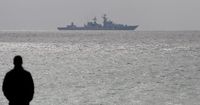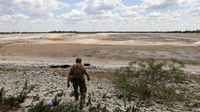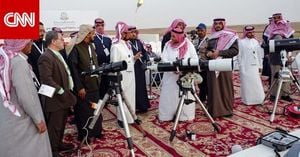In a significant development amidst the ongoing conflict between Russia and Ukraine, the United States announced that both nations have agreed to ensure safe civilian shipping in the Black Sea. However, this agreement comes with a caveat: Russia has conditioned its implementation on the lifting of numerous sanctions imposed against it. This revelation emerged following discussions facilitated by the U.S. in Saudi Arabia, where representatives from both countries met to address various aspects of the conflict.
U.S. President Donald Trump expressed skepticism regarding Russian President Vladimir Putin's intentions, suggesting that Putin might be deliberately stalling efforts for a ceasefire. Trump stated, "It’s possible that he’s playing for time," referencing his own experiences in negotiations where he would hesitate to sign agreements without complete certainty.
As tensions continue, Ukrainian President Volodymyr Selenskyj traveled to Paris on March 26, 2025, to meet with French President Emmanuel Macron. This meeting is part of the preparations for a summit of Ukraine's supporters scheduled for March 27, where leaders from various nations will discuss security guarantees aimed at ensuring any potential ceasefire is respected and that Russia does not launch further attacks.
While the U.S. and Ukraine have outlined a framework for safe maritime navigation, Russia has issued a series of demands that complicate the situation. These include restoring access to the Swift financial system for the Russian state agricultural bank and other institutions, as well as lifting the embargo on agricultural technology imports and various trade restrictions.
In a statement reflecting Ukraine's position, Selenskyj accused Russia of manipulation, asserting that the Kremlin's insistence on linking the ceasefire to sanctions is a tactic to gain leverage. He emphasized that the U.S. had made it clear that the ceasefire on the Black Sea should not depend on such conditions.
In a related context, the Kremlin presented a list of energy facilities that it claims would be protected under a mutual halt to attacks. This list includes oil refineries, pipelines, and power plants. However, Ukrainian officials have reported ongoing attacks on their energy infrastructure, with Selenskyj's advisor Dmytro Lytwyn stating that Russian forces have bombed Ukrainian energy facilities multiple times since March 18, despite the Kremlin's claims of adherence to the ceasefire.
Western allies are currently considering establishing air surveillance of a potential demilitarized zone between the opposing forces, utilizing satellites and drones. Additionally, there are discussions about deploying marine units to ensure the freedom of navigation in the Black Sea. However, any peacekeeping force would likely be mobilized through the United Nations and consist of troops from neutral third countries.
In another development, Russia reiterated its claim over the Zaporizhzhia nuclear power plant, which it has occupied since the beginning of the conflict. The Russian Foreign Ministry stated that the facility is a Russian nuclear installation and cannot be returned to Ukraine. This assertion comes amid Trump's expressed interest in Ukraine's nuclear industry, suggesting that the U.S. could effectively operate a Ukrainian nuclear power plant.
On March 25, Russian Foreign Minister Sergej Lawrow confirmed ongoing discussions with the U.S. about the potential restart of the Nord Stream gas pipelines, which have been dormant due to the conflict. Lawrow remarked that a normal energy supply for Europe is in the interest of both the U.S. and Russia, hinting at a possible American-Russian agreement that could facilitate the resolution of the Ukraine war.
Despite the ongoing negotiations, the situation remains precarious. On March 27, Russian forces launched drone attacks on Ukraine, with significant explosions reported in Krywyj Rih, Selenskyj's hometown. These attacks highlight the continued volatility of the region and the challenges facing both sides in reaching a lasting ceasefire.
The conflict has led to severe humanitarian consequences, with recent reports indicating at least 65 injuries, including children, from a Russian missile strike in the city of Sumy. As the war enters its fourth year, the plight of civilians continues to be a pressing concern.
In a striking display of defiance, Selenskyj posed for a photograph in front of a painting depicting the Kremlin in flames, a symbolic gesture that has drawn ire from Moscow. The artwork, titled "The Dream" by Georgian artist Sandro Antadze, represents Selenskyj's vision of victory over the ongoing aggression.
Amidst these developments, the Russian region of Orjol has introduced a controversial initiative offering financial incentives to schoolgirls who register pregnancies, aiming to combat the country's declining birthrate. This move reflects broader demographic concerns within Russia as officials seek to encourage higher birth rates.
As the diplomatic efforts continue, both sides remain entrenched in their positions. The U.S. and Russia have agreed on a joint declaration following their talks in Saudi Arabia, but the specifics of any agreement remain unclear. The complexity of the situation underscores the challenges in navigating a resolution to the conflict, with both nations holding firm to their demands.
In conclusion, the path to peace remains fraught with challenges as both Russia and Ukraine navigate a complex web of negotiations, military actions, and international diplomacy. The coming days will be crucial as leaders gather to discuss the future of Ukraine and the broader implications for regional stability.





